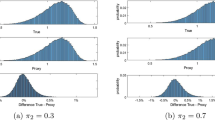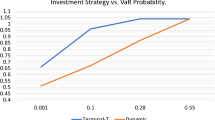Abstract
The paper starts from the preceeding paper by L. Peccati in this issue. The original model is enriched with corporate taxes and reinvestment possibilities.
The decomposition of NPV is used to study an optimal dynamic reinvestment policy.
A generalization of the model is outlined and a numerical example is provided in an appendix.
Similar content being viewed by others
References
Peccati L., Multiperiod Analysis of a Levered Portfolio, paper presented at the Fifth Meeting of the Euro Working Group on Financial Modelling, Catania, Italy, April 20–21, 1989.
IfI is an industrial investment, it seems to be more logical to think off s as rents.
Each addendum in turn is proportional both to the amount of capital to which it pertains and to the difference between its rate of return through I (ρ s for debt and equity, 1 for working capital) and its cost (opportunity costR s and zero for equity and working capital respectively, effective costδ s for debt).
In Peccati's model (see (7) above, to which (10) reduces whent s=1−b s=0,s=0, 1,2, ...,N) the contribution to the (s, s+1) addendum of discounted cash flow of each source of capital was the product of the capital in question times its spread: rate of return throughI (ρ s or one) minus cost (true or opportunity). Under our hypotheses the contribution is still the product of the amount of capital times its spread, but: i) as concerns equity, the spread is in terms of compound factors instead of rates, ii) as regards reinvestments, the opportunity cost does not appear.
i.e. if the net rate of interest corresponding to theIFL now (ρ s (1-t s )) is the same as the net rate earned in the previous model (ρ s , which was also a gross rate).
In fact, when i)b s =1,s=1, 2,...N, ii)ρ s (1-t s ) amounts toρ s in the previous model, the tax shield on debt isD s δ s t s.
See, for example, Whittle, P., Optimization over time, J. Wiley, New York, 1982.
The change in sign is due only to the formulation (12).
The hypothesis of a constant rate of return is introduced just in order to simplify notation: the reader can easily generalize it to the case in which this rate or return fluctuates over time.
See Luciano, E., Peccati, L., The decomposition of random cash flows, paper presented at the 5th FUR Conference, Durham, 1990.
Remind that retained earnings are rerouted.
Author information
Authors and Affiliations
Rights and permissions
About this article
Cite this article
Luciano, E. A new perspective on dynamic portfolio policies. Rivista di Matematica per le Scienze Economiche e Sociali 12, 91–106 (1989). https://doi.org/10.1007/BF02085594
Issue Date:
DOI: https://doi.org/10.1007/BF02085594




